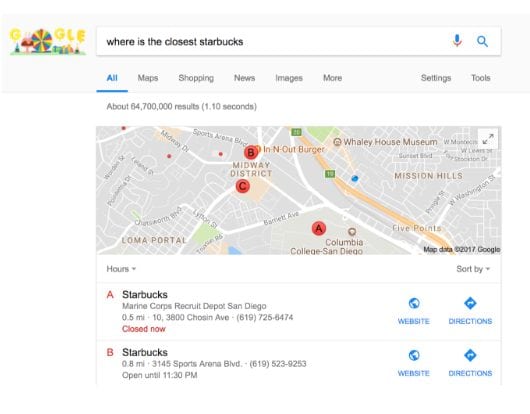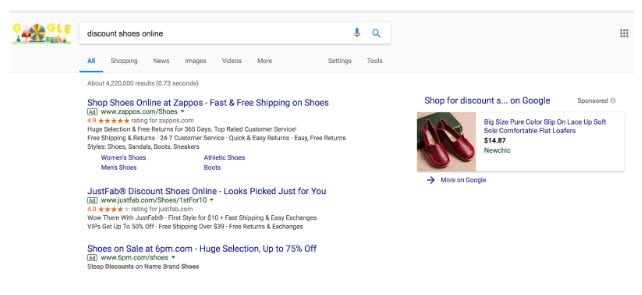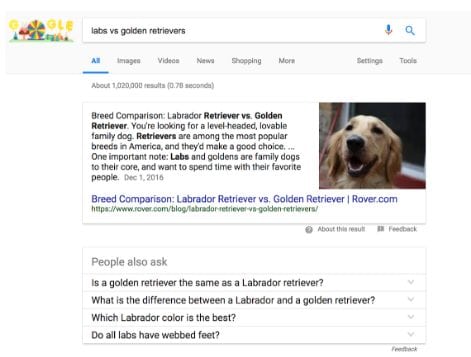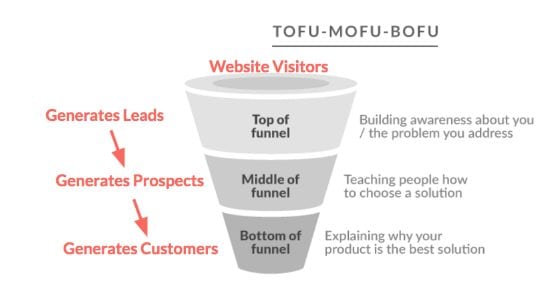If you are looking for the best way to tie your content and SEO strategy together content clusters are the best way to see impactful results.
Content clusters are quickly becoming a great way to establish their site as an authority on a range of topics. A core part of our content marketing strategy at Power Digital, contextual content clusters are a type of topic modeling strategy in which you create a “cluster” of content around one topic. While keywords ties into your topic cluster the overall idea is to model out your entire cluster of content to be as topically relevant as possible.
While content clusters are extremely powerful, there is a bit of a science to getting the results you want to see. We’re breaking down everything you need to know about content clusters to transform your content marketing strategy.
Understanding Keyword Types
Before you get started with selecting topics for your content cluster the first thing to understand is the search intent behind different types of keywords. Keywords can typically be broken into three core categories: navigational, transactional, and informational.
Navigational
Navigational keywords are the types of keywords you will likely rank for naturally as they are typically branded terms such as “how to get to the hard rock.” These are when people are looking for directions or simply looking to find something.

Transactional
Transaction keywords are the types of keywords that you would ideally like to rank for on the main product or service pages of your site. These are typically more transaction focused as the user knows what they want and is looking for the right product or solution. You will want to target these in the content on these types of pages. For example, if you ran an online clothing store some of the transaction keyword for your dresses page would include:
- Chic womens dresses
- Womens vintage style dresses
- Cute dresses

Informational
Informational keywords are the types of keywords you want to target with your content cluster as they are more top of funnel and support a strong topic modeling strategy. When people are searching around informational topics they are usually looking for educational resources that can help them learn more about the different products or services you offer. These keywords will vary from industry to industry as the types of information people seek will depend on how large of an investment they are making. Some examples of informational keywords include:
- What is content marketing
- How does content marketing work
- How long should a blog post be

TOFU – MOFU – BOFU
There are three different areas within marketing funnels that may influence your keyword research and cluster content. As mentioned above, informational keywords are most often top of funnel keywords because they indicate the user is earlier on in the buying cycle. As you move to the bottom of the funnel you will find people are searching around more transaction keywords as they are closer to making a decision.

So, what happens in the middle of the funnel? This is when users are trying to decide what exactly they want and aren’t ready to make a clear choice on which product or service fits their needs. They are considering their possible solutions and are in need of a ton of resources about the different options available. Your cluster strategy can definitely include some of these middle of the funnel topics where users are comparing products or services.
How To Pick Topics For Your Content Cluster
Never done topic clustering before? Don’t worry, developing a content strategy is really quite simple once you understand the foundation. One of the most important parts of the content cluster strategy is picking the right topics to build your cluster around. One of the first places you should start is with your transactional pages. These are the money-making pages of your website, making them priority number one for your content clusters. There are two reasons for this:
First, you want to build out content that is informative, but ties directly into your product or service offering. It’s important to make sure the top of funnel traffic you are bringing into your site organically is as relevant as possible. If you stray too far from what your target audience is interested in you’ll have a harder time pushing these users through the funnel and building up a relationship with them.
A secondary goal of content clusters is to build up the authority your site has around your main products and services. That’s why writing blog post articles about a core topic that relates to a pillar page is an excellent way to attract your target audience.

For a Crate&Barrel that would be their main navigational pages. They would want to build out content around each of the main navigation and subcategories they offer. You would want to build clusters around:
- Furniture
- Outdoor
- Tabletop & Bar
- Kitchen
- Decor
- Rugs
- Lighting
- Bed & Bath
From there, you would want to dive into the subcategories listed under every main category. For a brand like Crate&Barrel this could mean creating an almost countless amount of core topic clusters. The more content you put out around these specific topics, the better your core transactional pages will perform.
This is why it’s key to make sure you are building out truly holistic clusters around your target pages and not simply putting our four articles around each- it’s likely not enough. It’s important to remember that you can drip this content out and continue to build upon your existing articles by going back and linking to your new content. Creating a cluster around each doesn’t mean you need to write 20 articles in a row on sofas. Just be conscious of clustering all your content around sofas together through a strong internal linking strategy.
How Does Topic Modeling Work?
Why are content clusters so important? Content clusters are important largely in part due to the evolution of Google’s algorithm and the way we approach search engine optimization strategy today. Long gone are the days of keyword stuffing. As Google has advanced its algorithm and machine learning technology, the need to be topically relevant has become increasingly important.
Google RankBrain
The introduction of Google’s machine learning technology, Rank Brain has completely transformed the way Google returns search results. Before, Google used to return search results based specifically on the keywords you were searching for. Now, their algorithm has a more robust understanding of the topic you are searching for and looks to return the content that it deems the most relevant. This is why creating clusters of content around a specific topic is so effective. Google is looking to return the best results possible and is judging based on how relevant it predicts your site will be from “reading” your content.
Selecting Keywords For Your Content Cluster
When it comes to building out a content cluster strategy, the first thing you’ll want to do is identify informational keywords associated with your core transactional pages. While you are looking to build the cluster around topics, it’s important to know what blog post articles are highly searched within your overarching topic. Sometimes the most popular queries related to your product or service offering will surprise you. Never assume you know what to write about, let the numbers do the talking when it comes to finding related content.
From there you can carry out your analysis of which keywords you can rank for and which ones you want to pursue. As seen through the Crate&Barrel example, we typically look to build a large cluster around each main product or service. For example, if you were a spa that offered facials you should look to build out a ton of topic cluster content around the different questions and informational queries related to facials. Some examples of related topics are:
- How Often Should You Get a Facial If You Have Acne?
- What is Done During a Facial?
- How Often Should You Get a Facial Before a Wedding?
- At What Age Should You Start Getting Facials?
- Types of Facials
- Benefits of Facials
- Facial Types For Oily Skin
After you’ve identified a topic you can dive into alternate keywords to optimize for using tools like AdWords Keyword Planner and Keywordtool.io (shown below).
Once you deep dive into a topic you’ll find there are nearly an endless amount of related topics you can cluster together. In this example, the key to the success of your cluster would be to internally link your articles together and to link to your main facial service page in each article.
After you’ve exhausted all of your topics around facials you can then expand beyond the more facial-only topics and begin building cluster around related topics such as:
- Wedding Skincare
- Anti-aging Skincare
- Acne Skin Care
Anyone who is searching around facials would also likely be interested in learning more about facials, if not getting a facial. The reason it’s important to start with facials is that it is more closely related to the services you offer. However, people who are interested in learning more about facials are clearly concerned and interest in overall skincare. This is where clusters have the potential to transform your overall business and bottom line as they continue to bring in more top of funnel traffic with each article you add.
There is really no limit to the amount of content you should be putting out there. The more content you publish the more people will visit your site looking to you as a true resource and authority in the space. Don’t hold yourself back by feeling like every article you write needs to be extremely transactional or tie right back to your main product offering.
How Many Articles Should I Include The Content Cluster?
One of the most common questions people have about content clusters is how much content they need to produce. We have clients publishing anywhere from one article a month to 50+. While there is no perfect number, it’s not hard to guess which clients content strategy is performing better. This is simply put, because the more content you have on a topic the more relevant your site is likely going to be for queries related to that topic.
See an example below of a client who is seeing consistent growth since implementing the cluster strategy at the beginning of this year:
Needless to say, we recommend producing as much content as you can around your target topics. While this can seem daunting it’s important to go back to the key goals of the cluster which are to:
- Drive new users to your site at the top of the funnel
- Build up the authority and rankings of your key transactional pages.
When you look at it this way it’s easy to make the argument that you will never have “enough” content. There are always new topics and a wider net to cast in terms of top of funnel traffic. As you build out new content to add to each cluster just internally link it in and you are good to go.
How Long Should The Articles Be?
A key way to divide up your articles is to think of them as either long-form or short-form. Long-form articles are approximately 2,000+ words (often longer) and short-form are about 700-800 words. When it comes to deciding which topics you should write long- vs. short-form article about it’s important to consider the search volume and competition associate with the topic.
You should weigh the importance and relevance of the topic to your business. If it feels like a fringe topic that needs to be covered but doesn’t have the potential to be a major long-form article you can go with short-form. However, if the topic is one that would make a large impact on your business, has a high monthly search volume, and is competitive you absolutely should invest the time and resources into the piece.
At Power Digital, we often recommend that most articles in your cluster be on the longer end of things. This isn’t because we want to charge people more or make your want to claw your eyes out as you try to write 2,000 words on the search query “how to tie a tie.” Which, by the way, gets search over 400,000 times a month. We’ve seen longer articles get better result time after time. The reason they typically outperform shorter ones is because they are naturally more topically relevant. While you may argue against this, the fact of the matter is that Google is currently favoring articles that are longer in length due to the holistic nature of the content.
How To Create Topically Relevant Content
So, how can you make sure your content is topically relevant? One key part of this is as discussed above, making sure you have enough content written on the topic. If you get stuck brainstorming an easy way to get inspired is to look at the related searches around the topic you are writing about. Our favorite way is to use a platform called Market Muse to measure how topically relevant your content is. Instead of guessing how relevant your content is, or assuming it’s perfect because you’ve hit your 2,000 wordmark, Market Muse provides you with timely insights into the competition.
Market Muse essentially gives your content a score, shows you the average score (which varies based on each topic), and then shows you the score of the sites ranking in positions one through ten. The platform also outlines the word count of each page that is ranking on the first page. Which you can then use as a guide to what your target word count should be.
It is essentially your content marketing secret weapon as it gives you the pieces you need to improve your content and beat out the competition. One important thing to remember when using their platform is that each suggested topic is not just a keyword that should be stuffed into your content. You need to make sure that the content is topically relevant which is why Market Muse is a great tool to use when creating an outline for an article or looking to expand an existing article.
How To Craft A Strong Internal Linking Strategy
One of the most important parts of getting results with content clusters is having a strong internal linking strategy. Linking between articles gives Google messages that your content is related and allows you to pass authority between articles. That is why it’s extremely critical that you always be linking back up to your transactional pages and linking between other articles in the cluster.
When you are linking you should keep things as organic as possible while also being strategic with your anchor text. Anchor text is the text that is included in your hyperlink. You should ideally be using anchor text that matches the target keyword or topic of the post or page you are linking to.
The Final Step: Link Building
The final component of building out successful clusters is to get people to link from their site your resources. By getting people to link to your content it signals to Google that is it a valuable and relevant resource. The more sites that link to your content, the more authoritative Google sees you as. In an ideal world, sites linking to you would use the main topic you are trying to rank for as their anchor text when linking to you. Link building can make a big difference in not only the rankings of individual articles, but also the rankings of your main transactional pages, which is even better.
How To Measure Success The Success Of Your Content Cluster
Producing content clusters takes a lot of time, energy, and effort which is why it’s so important that you be able to measure their impact in a meaningful way. One of the first ways you can measure the success is by tracking your keyword growth using tools such as SEMRush. With a clear month-over-month trendline you can get a clear idea of how your keywords and traffic are trending.
In order to get an even better picture of the impact is to create a segment in Google Analytics so you can isolate and examine the specific cluster articles and track their traffic growth month over month. This will also give you insight into how many conversions these articles are driving. While conversions will not always be the main goal with more top of funnel articles it’s always nice to be able to track when they do come through.
When examining this traffic you should be looking closely at key metrics such as the time on site and pages/session. While higher bounce rates are more common on blogs it’s good to keep an eye on this and look to optimize your posts for higher engagement levels.
The next element of success you’ll want to keep an eye on is the keyword rankings and organic traffic trends for the core transactional pages your content clusters are built around. Remember that is one of the biggest objectives of content cluster and where you can see your efforts pay off in increased traffic, transactions, and revenue. You can track this by measuring your growth and increased keyword rankings for those specific transactional pages as well as creating segment of the pages the clusters support in order to measure the realized traffic and conversion growth.
How To Audit Your Content Clusters
Once you have begun producing content clusters it’s important to quickly audit them to make sure you are setting yourself up for success from the start. Here are the key points you should check off before publishing your content.
Topic Modeling
As discussed above, topic modeling is key to getting your clusters to rank. Make sure your content is typically thin and really dives into the key topics you are discussing. Consider all the questions and related topics people may think of and make sure you are thoroughly addressing all of the above.
Word Count
While it’s hard to put an ideal word count on anything make sure you are strategically investing in specific keywords and topics. Don’t skimp on topics that are near and dear to your product or service offering. Making that investment now will pay off big time down the road. Try and aim for 2,000-4,000 words. I know that sounds daunting, but when you really dig into those topics you’ll find that there is plenty to write about. The only catch with writing that much content is to make sure that the quality of content or information you are putting out there is not suffering as you try to hit your word count.
Internal Linking
You should ideally be internally linking to your core transactional page as well as every other topic in your cluster. There is no limit to the amount of times you can link to other pages on your website. We have never seen any consequences of linking too many times. Where you will see consequences however, is when you don’t like enough. Just double check that all of your links have optimized anchor text and you are good to go!
Volume of Content
Everything we’ve seen with content clusters tells us the more content the better. Don’t sell your efforts short by failing to truly commit to the strategy. It’s ideal to start with at least four articles around each topic and growth them out from there. You don’t need to try to spread yourself thin by creating content on every single topic that exists. Invest in your key topics that are relevant to your business and build from there. Chances are there is always more content you could put out and different angles you can take.
Research & Topic Selection
Make sure you are basing your clusters around some sort of research. Whether looking at keyword volumes, Google trends, competitors strategies, etc. you should be basing these topics around keywords and queries that will support your business. That being said, if you are in an emerging market it’s fine to go with your gut and lead the charge on tackling new topics. As for more established markets, try to start by targeting those topics and keywords that you can rank for and then build from there.
As you can tell given the integrated nature of the strategy, content clusters can make a large impact for the organic channel as it supports both informational and transactional keyword growth. When measuring your success it’s important to look at each holistically and not get caught up on the fact that every single one of your articles may not rank on page one. Look at the bigger picture and realize how important it is to make sure you are supporting your transactional service and product pages as they are likely your major drivers of revenue.







